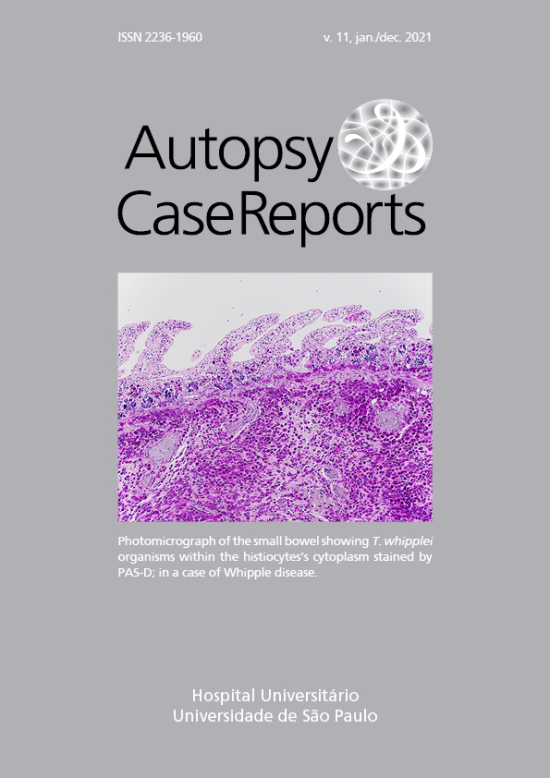Myelodysplastic syndrome in a 30-year-old man with coronavirus disease 2019 (COVID-19): a diagnostic challenge
DOI:
https://doi.org/10.4322/acr.2021.274Keywords:
Myelodysplastic Syndromes, COVID-19, Bone Marrow, Cytogenetics, SARS-CoV-2Abstract
Background: Myelodysplastic syndromes (MDS) mainly occur in the elderly but can rarely affect younger individuals too. The correct diagnosis relies on careful morphologic evaluation, cytogenetic/molecular results, and excluding reactive conditions mimicking MDS. We present the clinical, pathologic, cytogenetic, and molecular features of a case of MDS with excess blasts-2 (MDS-EB-2) in a 30-year-old male who was found to have pancytopenia during his hospitalization for coronavirus disease 2019 (COVID-19) and discuss the diagnostic challenges of MDS in patients with COVID-19. Case presentation: A 30-year-old man presented to an outside hospital with fever, chills, weakness, coughing spells, dizziness and shortness of breath and was diagnosed with bilateral pneumonia due to COVID-19. At the outside hospital, he was found to be pancytopenic, and a subsequent bone marrow aspiration and biopsy raised concern for a COVID-19 induced hemophagocytic lymphohistiocytosis. In addition, MDS could not be ruled out. The patient was thus referred to our institute for further management. The patient’s peripheral blood showed pancytopenia with occasional dysplastic neutrophils and a few teardrop cells. Given the diagnostic uncertainty, a bone marrow aspiration and a biopsy were repeated revealing a hypercellular bone marrow with erythroid hyperplasia, megakaryocytic hyperplasia, trilineage dysplasia, increased blasts (13%), many ring sideroblasts, and mild to moderate myelofibrosis, consistent with MDS-EB-2. Chromosomal analysis revealed isochromosome 14. Next generation sequencing demonstrated SF3B1 K700E mutation. Discussion and conclusion: The diagnosis of MDS can be challenging, particularly in young patients. Cytopenia and myelodysplastic features have been reported in COVID-19 patients, making the diagnosis of MDS more elusive. A careful pathologic examination of the bone marrow with ancillary studies including flow cytometry, immunohistochemistry, and cytogenetic and molecular studies in combination with a thorough clinical evaluation, leads to the accurate diagnosis.
Downloads
References
Ma X, Does M, Raza A, Mayne ST. Myelodysplastic syndromes: incidence and survival in the United States. Cancer. 2007;109(8):1536-42. http://dx.doi.org/10.1002/cncr.22570. PMid:17345612.
Rollison DE, Howlader N, Smith MT, et al. Epidemiology of myelodysplastic syndromes and chronic myeloproliferative disorders in the United States, 2001-2004, using data from the NAACCR and SEER programs. Blood. 2008;112(1):45-52. http://dx.doi.org/10.1182/blood-2008-01-134858. PMid:18443215.
Hasserjian RP, Orazi A, Brunning RD, et al. Myelodysplastic syndromes: overview. In: Swerdlow SH, Campo E, Harris NL, et al., eds. WHO classification of tumours of haematopoietic and lymphoid tissues. 4th ed. Lyon: IARC; 2017. p. 98-106.
Hasserjian RP. Myelodysplastic syndrome updated. Pathobiology. 2019;86(1):7-13. http://dx.doi.org/10.1159/000489702. PMid:30041243.
Bain BJ. The bone marrow aspirate of healthy subjects. Br J Haematol. 1996;94(1):206-9. http://dx.doi.org/10.1046/j.1365-2141.1996.d01-1786.x. PMid:8757536.
Parmentier S, Schetelig J, Lorenz K, et al. Assessment of dysplastic hematopoiesis: lessons from healthy bone marrow donors. Haematologica. 2012;97(5):723-30. http://dx.doi.org/10.3324/haematol.2011.056879. PMid:22180437.
Steensma DP. Dysplasia has a differential diagnosis: distinguishing genuine myelodysplastic syndromes (MDS) from mimics, imitators, copycats and impostors. Curr Hematol Malig Rep. 2012;7(4):310-20. http://dx.doi.org/10.1007/s11899-012-0140-3. PMid:23015360.
Della Porta MG, Travaglino E, Boveri E, et al. Minimal morphological criteria for defining bone marrow dysplasia: a basis for clinical implementation of WHO classification of myelodysplastic syndromes. Leukemia. 2015;29(1):66-75. http://dx.doi.org/10.1038/leu.2014.161. PMid:24935723.
Huang C, Wang Y, Li X, et al. Clinical features of patients infected with 2019 novel coronavirus in Wuhan, China. Lancet. 2020;395(10223):497-506. http://dx.doi.org/10.1016/S0140-6736(20)30183-5. PMid:31986264.
Chen N, Zhou M, Dong X, et al. Epidemiological and clinical characteristics of 99 cases of 2019 novel coronavirus pneumonia in Wuhan, China: a descriptive study. Lancet. 2020;395(10223):507-13. http://dx.doi.org/10.1016/S0140-6736(20)30211-7. PMid:32007143.
Rodriguez-Morales AJ, Cardona-Ospina JA, Gutiérrez-Ocampo E, et al. Clinical, laboratory and imaging features of COVID-19: a systematic review and meta-analysis. Travel Med Infect Dis. 2020;34:101623. http://dx.doi.org/10.1016/j.tmaid.2020.101623. PMID: 32179124.
Ahnach M, Ousti F, Nejjari S, Houssaini MS, Dini N. Peripheral blood smear findings in COVID-19. Turk J Haematol. 2020;37:286-309. http://dx.doi.org/10.4274/tjh.galenos.2020.2020.0262. PMID: 32586086.
Lüke F, Orsó E, Kirsten J, et al. Coronavirus disease 2019 induces multi-lineage, morphologic changes in peripheral blood cells. EJHaem. 2020;1(1):376-83. http://dx.doi.org/10.1002/jha2.44. PMID: 32838398.
Nazarullah A, Liang C, Villarreal A, Higgins RA, Mais DD. Peripheral blood examination findings in SARS-CoV-2 infection. Am J Clin Pathol. 2020;154(3):319-29. http://dx.doi.org/10.1093/ajcp/aqaa108. PMid:32756872.
Zini G, Bellesi S, Ramundo F, d’Onofrio G. Morphological anomalies of circulating blood cells in COVID-19. Am J Hematol. 2020;95(7):870-2. http://dx.doi.org/10.1002/ajh.25824. PMid:32279346.
Prieto-Pérez L, Fortes J, Soto C, et al. Histiocytic hyperplasia with hemophagocytosis and acute alveolar damage in COVID-19 infection. Mod Pathol. 2020;33(11):2139-46. http://dx.doi.org/10.1038/s41379-020-0613-1. PMid:32620916.
Gupta V, Brooker C, Tooze JA, et al. Clinical relevance of cytogenetic abnormalities at diagnosis of acquired aplastic anaemia in adults. Br J Haematol. 2006;134(1):95-9. http://dx.doi.org/10.1111/j.1365-2141.2006.06105.x. PMid:16803574.
Soupir CP, Vergilio JA, Kelly E, Dal Cin P, Kuter D, Hasserjian RP. Identification of del(20q) in a subset of patients diagnosed with idiopathic thrombocytopenic purpura. Br J Haematol. 2009;144(5):800-2. http://dx.doi.org/10.1111/j.1365-2141.2008.07508.x. PMID: 19055669.
Jacobs KB, Yeager M, Zhou W, et al. Detectable clonal mosaicism and its relationship to aging and cancer. Nat Genet. 2012;44(6):651-8. http://dx.doi.org/10.1038/ng.2270. PMid:22561519.
Bacher U, Schanz J, Braulke F, Haase D. Rare cytogenetic abnormalities in myelodysplastic syndromes. Mediterr J Hematol Infect Dis. 2015;7(1):e2015034. http://dx.doi.org/10.4084/MJHID.2015.034. PMID: 25960862.
Cui W, Bueso-Ramos CE, Yin CC, et al. Trisomy 14 as a sole chromosome abnormality is associated with older age, a heterogenous group of myeloid neoplasms with dysplasia, and a wide spectrum of disease progression. J Biomed Biotechnol. 2010;2010:365318. http://dx.doi.org/10.1155/2010/365318. PMid:21331167.
Busque L, Patel JP, Figueroa ME, et al. Recurrent somatic TET2 mutations in normal elderly individuals with clonal hematopoiesis. Nat Genet. 2012;44(11):1179-81. http://dx.doi.org/10.1038/ng.2413. PMid:23001125.
Laurie CC, Laurie CA, Rice K, et al. Detectable clonal mosaicism from birth to old age and its relationship to cancer. Nat Genet. 2012;44(6):642-50. http://dx.doi.org/10.1038/ng.2271. PMid:22561516.
Downloads
Published
Issue
Section
License
Copyright (c) 2021 Autopsy and Case Reports

This work is licensed under a Creative Commons Attribution 4.0 International License.
Copyright
Authors of articles published by Autopsy and Case Report retain the copyright of their work without restrictions, licensing it under the Creative Commons Attribution License - CC-BY, which allows articles to be re-used and re-distributed without restriction, as long as the original work is correctly cited.



